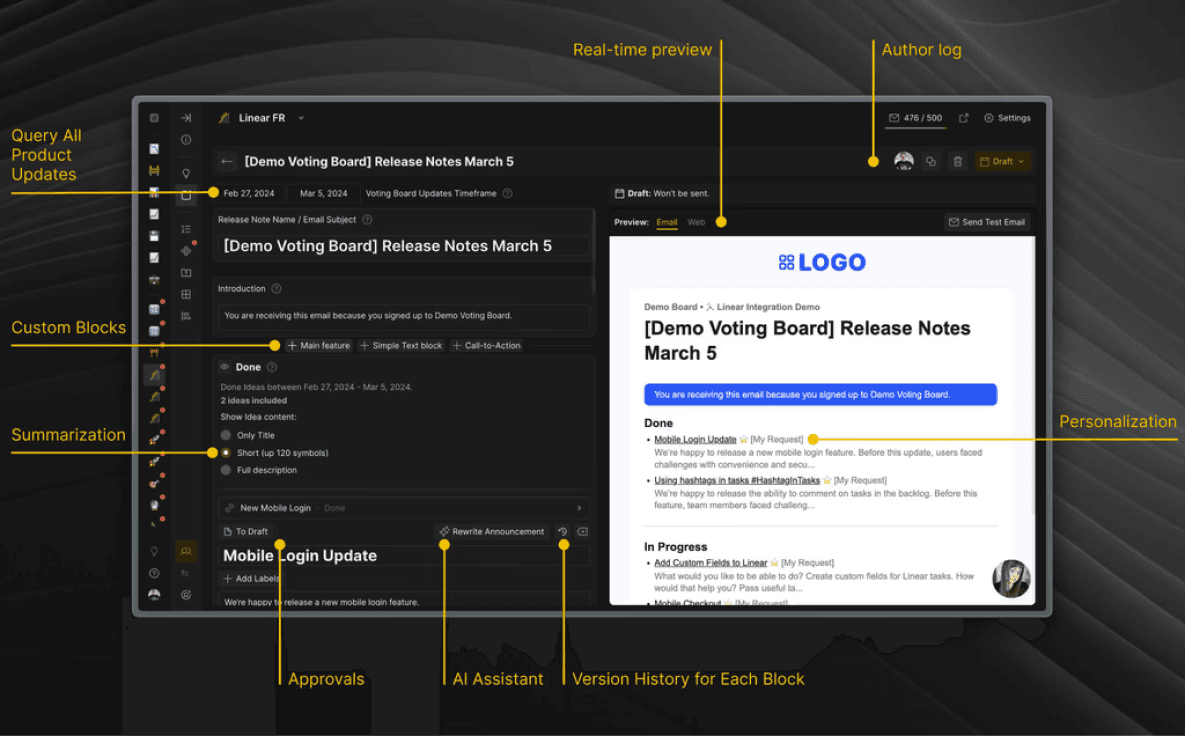How to Capture Feedback from Slack and Send It to Linear

When teams collect feature requests or bug reports in Slack, valuable input often gets lost in endless threads and direct messages. Without a structured way to capture this feedback, it becomes difficult to prioritize, track, or turn requests into actionable work items.
In this article, we’ll explore how to set up this workflow step by step — inspired by a real customer use case — so your team can manage requests efficiently and keep everything in one place.
User Goal:
🏎️ 💡A systematic approach to manage support escalations and customer requests, manage alignment, track and communicate ask completion, and automate release note creation from the Linear issues.
Problem
The problem is that feedback is being collected in Slack, but there’s a need to centralize all these requests in one place and then send them to Linear for development.
Company industry: Technology, Information and Internet, Medicine and Healthcare
Company size: 201–500 employees
Teams: Development & IT, Support, Product
Roles: Data & Analytics Manager, Developer
Tools used regularly: Linear, Slack
Yeah, this is awesome. Everything that you just showed me, I used to do it manually for years, and that's why when I actually found you online, I was like, "There's no way." But yeah, this is exactly what I need.
Our customer about Ducalis
Pain Points
Lack of centralized system: Without a centralized system, managing and prioritizing requests becomes chaotic.
Multi-stakeholder collaboration: Collaborating with multiple stakeholders from different teams and departments (content, design, sales, product, etc.).
Manual effort: Required to create Linear issues for development work.
Status monitoring: Monitoring and updating status and results for every step of their workflow
Prioritization challenges: Prioritizing requests and tasks.
The flow would actually be sending Slack request to Ducalis, prioritizing them, pushing them to Linear.
Solution: All Your Feature Requests in One Place
Ducalis offers seamless integration with Linear and Slack to help address these challenges:
Centralized Management: Collect, organize, and prioritize feedback in one platform—enhancing decision-making and reducing delays.
Feedback Delivery to Linear: Push feature requests and bug reports into Linear for execution.
Automated Tracking: Automatically sync feedback between Ducalis and Linear.
Streamlined Communication: Keep teammates informed with automatic updates.
Use a simple workflow that collects requests from Slack in Ducalis and then sends them to Linear as new issues. You centralize all incoming requests, streamline your feedback process, and ensure every idea becomes trackable and actionable.
Step 1: Setting up your data Voting board
A dedicated Ducalis Voting Board—a centralized hub for product feedback. It helps you track, categorize, and prioritize various types of customer input, ensuring your team stays aligned with user needs.

Navigate to the "Voting Board" section. Turn it on.

Check the privacy level—who can create/forward new requests and what they can see.

Name something obvious, like "[Team Name] Requests," so people know exactly where to go.
Make it welcoming: Upload your team logo, choose color that match your company branding, use your company domain for voting board address, and email notification. Read more here.

Step 2: Collect Requests From Slack
There are countless chats, workspaces, and conversations happening in Slack. It's easy to get overwhelmed and miss important ideas. Effortlessly extract ideas, feature requests, and bug reports from Slack discussions. Let users share their thoughts without disrupting their Slack experience.

Go to All Voting Boards, find Capture Ideas and choose Create Ideas From Slack Bot.

Then, go to the Slack discussion, choose the message you want to capture, and find the Ducalis bot.

Fill the form and create an idea.

Edit the idea, make any necessary changes, and publish it on the Voting Board.

Other Sources to Get Requests
Turn conversations into ideas with the Ducalis <> Discord integration,
Create a public idea from a Mattermost channel,
Connect via API to push requests from any internal system,
Embed the board in the internal portal
Pro tip: use AI assistant to re-write structured request description.
Step 3: Linear <> Ducalis: Turning Feedback into Action
To have the full picture of all your backlog tasks/bugs and those reported on the Voting board, you need to connect Linear.
Why It's Important to Connect Linear:
Push to Linear: Once a request is ready to move into development, you can either push a new issue in Linear or link the feedback item to an existing one—ensuring a smooth handoff between feedback collection and execution. Simply click "New" → "In Linear."

Automatic updates: Ducalis can automatically update your public roadmap. Save time with automations by going to "Set up Auto Updates Rules."

User notifications: Users who submitted or voted on requests are notified when their feedback is addressed—closing the feedback loop and reinforcing transparency, trust, and engagement.

To get started:
Navigate to Connect at the bottom left.
Choose Linear and authorize it.
Import your Linear data—projects, initiatives, issues.

All available integrations: Jira Server, Jira Cloud, GitHub, Asana, ClickUp, Trello, YouTrack.
Step 4: Create a simple request template (Optional but Recommended)
It helps structure forwarded feedback from Slack, Telegram, email, etc., and ensures the right details are captured using templates.

Click "Voting" settings > "Idea Template" and create fields like:
What do you need?
Why is this important?

Pro tip: Keep it short! People won't fill out a 10-field form but will happily complete 2-3 quick questions.
Step 5: Organize and Categorize Feedback (Optional but Recommended)
Structure requests on your Voting Boards to help teams manage and prioritize feedback effectively.
Apply labels to each idea (urgency, product area, customer type, status. This classification enables easy filtering, trend analysis, and prioritization.

To avoid clutter and redundancy, regularly review requests to merge duplicates or similar ideas, and move or copy ideas between boards as needed.

Use custom progress statuses (e.g., "New," “For Prioritization”, "In Progress," "Testing", “Released”) to track the development stage of each idea.

Step 6: Send Release Notes (Optional but Recommended)
Nobody likes working in a black box: Even with the best prioritization, people want to know their request was received and what's happening with it.
Send Release Notes — detailed information about tasks completed during a defined period.

Ducalis offers a customizable release note template and helps automate the process, so you can forget about doing it manually.

Step 7: Prioritizing Customer Feedback and Feature Requests (Recommended)
Prioritizing feedback helps you identify which features will provide the greatest value to your customer base and focus your efforts accordingly.
Keep it simple to start.
Ducalis has kick-off templates: choose between RICE or WSJF, and start with what resonates more with your business needs. Try to prioritize a few items.
Modify the prioritization criteria to reflect your business needs.
For example, for data requests, you might want:
- Business Impact: How much will this help the business?
- Urgency: How soon do we need this?
- Effort: How complex is this request?

Results You Can Expect with Ducalis.io
Organized and Actionable Feedback
Centralize feedback from all channels—Slack, Telegram, email, and more—into one structured system. Eliminate scattered input and ensure every idea is captured, categorized, and easy to act on.Faster, Smarter Product Decisions
Prioritize feedback based on business goals and user impact. Focus your team’s time and resources on building what truly matters.End-to-End Feedback Lifecycle Management
Manage everything in one place—from capturing user input to scoring and prioritizing, planning your roadmap, and publishing release updates and changelogs.Seamless Workflow Integration
Connect Ducalis with your existing tools like Linear, Jira, Asana, Trello, YouTrack, ClickUp, Slack, Telegram, Discord, and more. SSO support ensures smooth onboarding and secure access across teams.Cost-Effective and Scalable
Benefit from a value-based pricing model that charges based on the impact the platform delivers—not per user seat—making it an affordable choice for growing teams.Transparent and Customer-Driven Development
Track new features publicly on the Ducalis Feedback Board. See what’s being built, suggest ideas, and stay aligned with a company that listens to its users.
Ducalis—The Decision-Making Toolkit
Ducalis helps companies capture user requests, estimate job size, prioritize the backlog, inform about new features, and much more.
“Now our team actually agrees on priorities.”



















